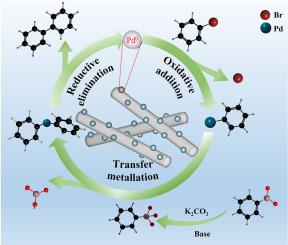Synergistic tuning of the phase structure of alumina in supported palladium catalyst for enhanced Suzuki-Miyaura coupling reaction
IF 2.1
3区 化学
Q3 CHEMISTRY, INORGANIC & NUCLEAR
引用次数: 0
Abstract
Suzuki coupling reactions are widely employed in natural product synthesis due to their high efficiency and selectivity in constructing target molecules. The development of heterogeneous palladium-based catalysts and sustainable ligand-free catalytic systems remains a key focus in Suzuki coupling research, aiming to minimize environmental impact, enhance resource utilization, and advance the sustainability of chemical processes. In this study, Al2O3 precursors were synthesized via electrospinning, followed by calcination at varying temperatures to produce different crystalline forms of Al2O3. Pd/Al2O3-x catalysts were then prepared using an impregnation method. The structural properties of the synthesized catalysts were systematically characterized using SEM, TEM, XRD, XPS, BET, and FTIR. The results demonstrate that the catalysts exhibit a fibrous tubular morphology with uniform Pd dispersion, thereby increasing the number of active Pd nanoparticles. Notably, γ-Al2O3 exhibited stronger interactions with Pd compared to the other crystalline forms. The resulting material demonstrated exceptional catalytic performance in Suzuki coupling reactions, achieving a high turnover frequency (TOF = 3186.1 h-1). The effects of reaction temperature, time, solvent, and base on catalytic efficiency were systematically investigated in this work. Moreover, the catalyst maintained stable activity over five reaction cycles, highlighting its excellent recyclability and reusability.

负载型钯催化剂中氧化铝相结构的协同调谐及增强Suzuki-Miyaura偶联反应
铃木偶联反应因其高效、选择性地构建靶分子而在天然产物合成中得到广泛应用。发展多相钯基催化剂和可持续无配体催化体系是铃木偶联研究的重点,旨在减少环境影响,提高资源利用率,促进化学过程的可持续性。在本研究中,通过静电纺丝法合成了Al2O3前驱体,然后在不同温度下煅烧,得到了不同晶型的Al2O3。然后采用浸渍法制备了Pd/Al2O3-x催化剂。采用SEM、TEM、XRD、XPS、BET和FTIR对合成催化剂的结构进行了表征。结果表明,催化剂呈纤维管状,钯分散均匀,从而增加了活性钯纳米颗粒的数量。值得注意的是,与其他晶体形式相比,γ-Al2O3与Pd的相互作用更强。所得到的材料在铃木偶联反应中表现出优异的催化性能,实现了高周转率(TOF = 3186.1 h-1)。系统地考察了反应温度、时间、溶剂和碱对催化效率的影响。此外,该催化剂在5个反应周期内保持稳定的活性,突出了其良好的可回收性和可重复使用性。
本文章由计算机程序翻译,如有差异,请以英文原文为准。
求助全文
约1分钟内获得全文
求助全文
来源期刊

Journal of Organometallic Chemistry
化学-无机化学与核化学
CiteScore
4.40
自引率
8.70%
发文量
221
审稿时长
36 days
期刊介绍:
The Journal of Organometallic Chemistry targets original papers dealing with theoretical aspects, structural chemistry, synthesis, physical and chemical properties (including reaction mechanisms), and practical applications of organometallic compounds.
Organometallic compounds are defined as compounds that contain metal - carbon bonds. The term metal includes all alkali and alkaline earth metals, all transition metals and the lanthanides and actinides in the Periodic Table. Metalloids including the elements in Group 13 and the heavier members of the Groups 14 - 16 are also included. The term chemistry includes syntheses, characterizations and reaction chemistry of all such compounds. Research reports based on use of organometallic complexes in bioorganometallic chemistry, medicine, material sciences, homogeneous catalysis and energy conversion are also welcome.
The scope of the journal has been enlarged to encompass important research on organometallic complexes in bioorganometallic chemistry and material sciences, and of heavier main group elements in organometallic chemistry. The journal also publishes review articles, short communications and notes.
 求助内容:
求助内容: 应助结果提醒方式:
应助结果提醒方式:


